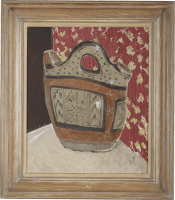This is a late work by the society portraitist and modernist Glyn Philpot. It was painted after a succession of trips Philpot took to Paris and North Africa between 1931 and 1933 and marks a divisive move away from his established medium of portrait painting.
Depicting an intricately patterned African vessel set against a vibrant red and ochre background, Philpot’s use of earthy tones alongside bold lines signals a departure from the realism of his well-known portraiture. The composition emphasises the contrast between the textured, decorative jar and the simplified surrounding space. In 1931 Philpot moved to Paris to immerse himself with the avant-garde circles that had championed post-impressionism, cubism and their studies of African art. In 1933, he visited North Africa with artists Oliver Messel and his partner the artist Vivian Forbes. Painted either during his trip, or just after, Still Life (Jar) depicts a large, highly decorated African earthenware vessel of black, terracotta and brown against a vibrant...
This is a late work by the society portraitist and modernist Glyn Philpot. It was painted after a succession of trips Philpot took to Paris and North Africa between 1931 and 1933 and marks a divisive move away from his established medium of portrait painting.
Depicting an intricately patterned African vessel set against a vibrant red and ochre background, Philpot’s use of earthy tones alongside bold lines signals a departure from the realism of his well-known portraiture. The composition emphasises the contrast between the textured, decorative jar and the simplified surrounding space. In 1931 Philpot moved to Paris to immerse himself with the avant-garde circles that had championed post-impressionism, cubism and their studies of African art. In 1933, he visited North Africa with artists Oliver Messel and his partner the artist Vivian Forbes. Painted either during his trip, or just after, Still Life (Jar) depicts a large, highly decorated African earthenware vessel of black, terracotta and brown against a vibrant background of red which Philpot has added to with strokes of ochre. Even though it is a highly decorated work it is markedly simplified where the line and form of the jug and intersection of wall and floor are at the forefront.
Still Life (Jar) was exhibited at Philpot’s Leicester Galleries exhibition of 1934, which was met with praise from his contemporaries. One journalist noted: ‘Mr. Philpot is an eclectic in that he seeks to combine the best qualities of various modern schools, chiefly among the post-impressionists – a dangerous endeavour. But that is not to be held against him. He is never tragic, often very gay, and never boring. He provided what, after all, art must do in some way, pleasure – pleasure in light and well-balanced colour, in design, and in vividly presented subject-matter.’[1] This exhibition exemplified Philpot’s bold exploration of colour and form in his later years, blending the influences of his travels with a modernist sensibility.
[1] Liverpool Daily Post, 12 Feb 1934, p.7.




